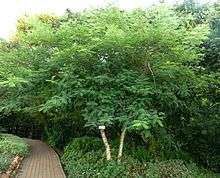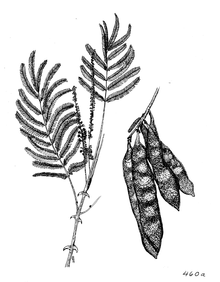Senegalia polyacantha
Senegalia polyacantha, also known as White Thorn is a flowering tree which can grow up to 25m tall. Polyacantha has the meaning "many thorns" in Latin.[2] The tree is native to Africa, India, the Indian Ocean and Asia, but it has also been introduced to the Caribbean.[1]
| Senegalia polyacantha | |
|---|---|
 | |
 | |
| Scientific classification | |
| Kingdom: | |
| (unranked): | |
| (unranked): | |
| (unranked): | |
| Order: | |
| Family: | |
| Genus: | |
| Species: | S. polyacantha |
| Binomial name | |
| Senegalia polyacantha (Willd.) Seigler & Ebinger | |
| subspecies | |
| |
| Synonyms[1] | |
Uses
Repellent uses
The root of Senegalia polyacantha subsp. campylacantha emits chemical compounds that repel animals including rats, snakes and crocodiles.[2]
Gum
The tree's gum is used in the manufacture of candy.[2]
Medicinal purposes
S. polycantha's roots and perhaps its bark have medicinal uses. The root extract is useful for snakebites[2] and is applied to wash the skin of children who are agitated at night time.[2] The root is also used for treating gonorrhea,[3] venereal diseases,[4] dysentery[4] and gastrointestinal disorders.[4]
References
- ILDIS LegumeWeb(ILDIS)
- PlantZAfrica.com
- van der Maesen, L. J. G.; van der Burgt, X. M.; van Medenbach de Rooy, J. M. (1996). The Biodiversity of African Plants. Springer Science+Business Media. p. 254. ISBN 0792340957. Retrieved 10 November 2012.
- Uhlig, Siegbert (2003). Encyclopaedia Aethiopica: A-C. Harrassowitz Verlag. p. 66. ISBN 3447047461. Retrieved 10 November 2012.
- Speedy, Andrew. "Acacia polyacantha". www.fao.org. Retrieved 3 August 2017.
| Wikimedia Commons has media related to Senegalia polyacantha. |
| Wikispecies has information related to Senegalia polyacantha |